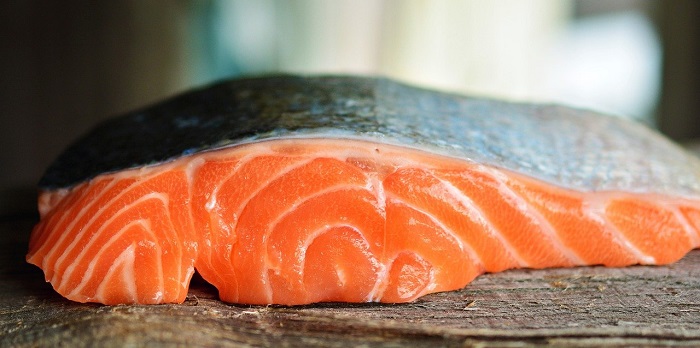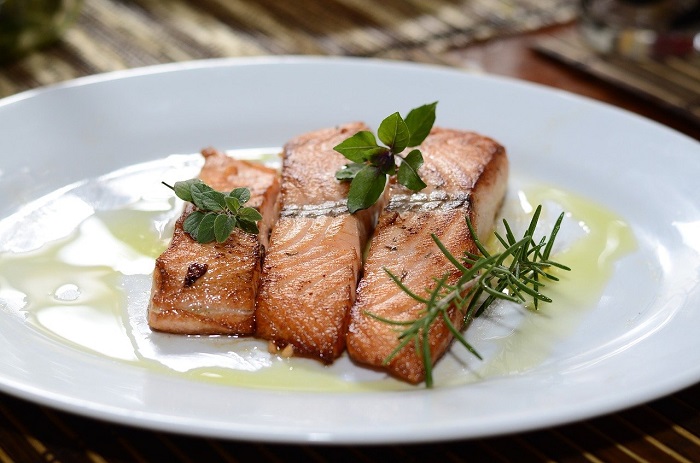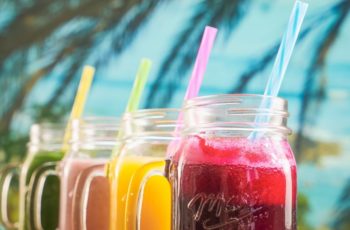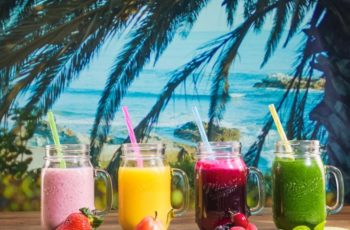Table of Contents
How Long to Cook Salmon at 350? Good Cooking Tips in 2021
Have you ever wondered how long to cook salmon at 350? There are a lot of factors that can affect the cooking time, so it’s important to have a good idea of what type of fish you’re working with. This article will help answer your questions and provide some helpful tips for cooking different types of fish!
What is Salmon?
Salmon is one of the most popular fish consumed in the United States. It has a mild, meaty flavor that is easy to match with other flavors as well as a firm texture that makes it good for sautéing, grilling and broiling. More than 80 percent of all salmon sold in this country comes from Alaska. Salmon also happens to be an excellent source of many vitamins and nutrients because they are high in omega-3 fatty acids.

How Long to Cook Salmon at 350?
Salmon that has been cut into steaks or fillets and placed in a baking dish, covered with plastic wrap and aluminum foil should be cooked at 350 for approximately 15 to 18 minutes per inch of thickness. The internal temperature should reach 145 degrees F as measured by an accurate thermometer. Allow the salmon to stand for about 5 minutes before removing the skin (which will now peel off very easily).
This resting period allows the juices to redistribute evenly throughout the meat so that it does not become dry.
Is that clear for the question: How Long to Cook Salmon at 350?

Steps by steps on baking Salmon at 350?
1. Make sure your fish is fresh and has been stored properly, if not it will spoil easily even while being cooked.
2. Remove the plastic wrap from the baking dish and place some lemon slices inside to add flavor to the salmon.
3. Place your fish fillet in a diagonal position on your greased baking pan measuring approximately 6 by 10 inches or any size as long as you have space for covering the salmon with aluminum foil (otherwise use two pans).
At this point, we also like to lightly season our meaty fish with pepper or salt but only a small amount required since there are other steps wherein you could experiment with different flavors including herbs, spices or butter/olive oil/lemon juice etc… Try adding or substituting any ingredient you have on hand. Flavor your salmon as much as you want and always remember about the simple things like pepper, salt, etc…
4. Cover your baking dish with greased aluminum foil (or 2 layers doubled), pour in 1 cup of water to avoid drying out your fish, cover tightly with more aluminum foil and place in a preheated oven at 350 for approximately 15-18 minutes per inch of thickness.
Remember that it is preferable to use an accurate digital thermometer to make sure that its internal temperature reaches 145 degrees F which means that it’s done cooking. After taking it out from the oven allow 5-10 minutes before serving then simply remove the skin and eat! Enjoy!
5. You can now prepare a simple or elaborate side dish to match your salmon such as steamed broccoli, baked carrots, twice-baked potatoes and so on. You may also want to try it with Japanese rice and soy sauce (this is especially good), Spanish rice and lemon juice, etc…
You are not bound to any recipe or ingredient just make sure that you enjoy!
Good tips and Guide on Baking Salmon at 350.
1. How to choose a good quality of Salmon?
- The flesh should be firm and smooth with a rosy pink color (never yellow or orange).
- The eyes should be bright, clear and bulge slightly as they are filled with liquid.
- The gills should be red in color and the skin should appear moist without any brown marks (these are signs of spoilage). Once you get home put your fish in the refrigerator immediately if it is going to stay for just one day but if longer than that try freezing it at 0F degrees or below.
- It is preferable to prepare freshly frozen fish than previously frozen ones since fresh ones are never pre-cooked while the latter has been cooked before freezing which makes their texture and flavor lose its originality once thawed out.
2. How to store Salmon?
Basically, you want to keep it at a temperature of about 32F degrees. It will last for up to two weeks but if frozen it will stay fresh and in good condition longer than that (up to 6-8 months). Make sure you completely defrost it before cooking and never refreeze without adequate thawing.
Remember these simple rules when storing salmon: Keep it covered properly with water, use proper storage bags/containers/wrappers, avoid direct sunlight or strong heat sources like the stove or grill etc…
3. How long does cooked Salmon keeps its taste?
It all depends on how well prepared and stored. Generally speaking, white fish like salmon lasts for 2-3 days in an unopened container while whole salmon lasts about 2-3 weeks in the fridge. This head start could be a plus if you are planning on cooking for several guest or just want to store your food for later use (always label your packaging date and contents). If properly prepared, stored and handled it might last even longer.
4. Healthy Benefits of Salmon Why Eat Them?
There are some benefits of Salmon as below:
a. Rich in vitamins and minerals:
They contain high amounts of vitamin A which is essential for good vision maintenance, skin health as well as cell repair keeps our system running smoothly overall. Another one is vitamin D that helps maintain strong bones by helping us absorb calcium from foods we eat every day.
Next, Iron which plays a major role in producing red blood cells known as hemoglobin that carry oxygen to your cells. Other vitamins and minerals content include B12, folate, niacin and riboflavin which is essential for digestion and good circulation around the body along with a high amount of protein that helps in building strong muscle mass.
b. Fatty acids/Omega-3:
Salmon meat contains two important yet famous omega fatty acids known as Omega-3 (Alpha Linolenic Acid) and DHA (Docosahexaenoic acid). Another one also found in salmon is EPA or Eicosapentaenoic Acid made from ALA mainly found in nuts, seeds, flaxseed oil, soybean oils etc… These acids are known as “good fats” because they help reduce blood pressure and bad cholesterol (LDL) levels that are mainly caused by saturated fat intake from animal source foods.
c. Protein:
Salmon has a high amount of protein which makes it an excellent choice for vegans/vegetarians who do not consume meat such as chicken, beef etc… Protein is vital in building muscle mass along with repairing damaged tissues and cells located all around the body once we have sustained an injury or when recovering from a surgery or illness.
This helps speed up your recovery process by helping you feel better sooner! It also serves to build antibodies and enzymes that fight infection in our body.
d. Avidin:
A protein found only in salmon eggs that can cause food allergy if eaten raw or undercooked (Avidin is destroyed at a temperature above 158F degrees). This substance binds Vitamin B12 thus preventing its absorption in our intestine system leading to severe health issues such as neural damage and nerve degeneration.
This has led to certain medical procedures whereby people who have allergies towards raw or undercooked eggs (especially salmon) have their Vitamin B12 injected which is required by our body to produce healthy red blood cells and nerve sheaths.
e. Liver:
Salmon liver is one of the best sources for health benefiting nutrients such as Vitamin A and D, selenium, choline and B vitamins like niacin (B3), riboflavin (B2) & folate (B9).
Vitamin A plays a major role in maintaining healthy vision by keeping eyes sensitive to light, it also helps our nervous system function well that allows us to see everything we do every day, produce steroid-like hormones used in energy production throughout the body and synthesize many proteins needed for cell repair and growth.
5. What to consider before buy Salmon?
The color of the salmon should be pink, not dark red. Pink means that it is fresh, and it will have a good taste! If you buy salmon which is dark-red in color, it may be old because this type of salmon tends to turn into a darker shade when they are kept for some time.
If the salmon has no scales or small scales, it’s probably farmed one. Check their eyes! Wild salmon always have big wide eyes, while those fish raised in farms often show small black dots instead of eyes because they don’t need to see much since they live under water most of the time.
The place where you’ve bought them from is also important. You shouldn’t buy your wild caught Alaskan salmon from a grocery store. You should buy it directly from the fishermen or fishmongers, for example, at Pike Place Market in Seattle.
If you are familiar with these types of products, you will probably know what to look for when determining whether or not your chosen item is fresh and healthy. If not, then this article may be able to help you out!
The above explanation shows us that farm-raised salmon tends to have different characteristics than wild-caught ones. It’s important to choose wisely because we wouldn’t want ourselves to eat unhealthy food!
In conclusion, I would like to say again why I chose Alaskan Salmon over farmed Salmon: There’s no comparison between both of them .
The Alaskan Salmon benefits us in many ways and has no negative side effects on our body. Although the wild caught salmon is more expensive than the farmed one, I believe that it’s worth paying for!
6. Where to buy Salmon?
If you are looking for a place where to buy salmon, please consider buying Salmon from reputable and sustainable sources. By doing this, not only will the fish taste better, but it also helps the fishermen and their families .
Another great way is to find local fishermen or fishmongers near your area (try asking your neighbors!). This helps you to know that you’re getting an authentic product by directly dealing with partners who understand the value of quality.
They can tell if their product was frozen before or just right after catching them. Since Alaskan Salmon live in cold waters year-round , they tend to be frozen several times before reaching our markets. Before freezing process, raw products undergo processing which includes cleaning and cutting before being frozen .
Always remember that if you are looking for a delicious, fresh and healthy salmon, always look for Alaskan Salmon!
7. What Side Dish with Salmon?
When having Salmon, it is always nice to pair it with a side dish. Shown above are some of the most common side dishes people like to pair with salmon:
Beans and corn: Cooked beans (kidney or great northern) and fresh corn makes for an easy, delicious side. But using canned ones will make this dish look very unappetizing since you’ll get huge chunks of vegetables in your plate! Try choosing a can that says “all natural” on the front. If you want more color, add chopped bell peppers.
Brown rice pilaf: This is a very easy dish to make. You can follow the instructions on most of the boxes. To spice it up, add chopped bell peppers (red or green) in the pan before pouring in the rice mixture and cook for about 3 minutes with your salmon fillets.
Cauliflower gratin: Very simple side dish! Chop cauliflower, onions, cheese and butter into small pieces. Add cheese and bread crumbs on top of this mixture and bake until golden brown! (You can also alternate mozzarella with cheddar!).
Brussel Sprouts: This is one of my favorites! Brussel sprouts are really low in fat but high in fiber. So don’t forget to always choose fresh ones when shopping at grocery stores.
Make sure to buy them as fresh as you can find them. Freezing and thawing destroys some of the nutritional value (including vitamins A, C, and E), so if they are frozen, it’s best to use them in soups or stews instead of roasting or sautéing. Once cooked, add butter and salt for a tasty side dish!
Garlic Mashed Potatoes: If you’ve never had mashed potatoes with garlic before, try this recipe. It is easy and very delicious! Wash your potatoes well then peel each one from top to bottom. You’ll need about four medium-sized ones for four people. Cut into cubes (to yield chunks), place in your pot, cover with water and boil until soft. Drain then add chopped garlic, butter, salt and pepper.
To make your mashed potatoes extra creamy, you can use butter milk instead of whole milk (it will be healthier too!) or try adding sour cream for a richer taste! This is an easy side dish that works well with most kinds of fish!
Asparagus: Boil your asparagus until tender then cut into bite-size pieces. You may want to season this with some salt and pepper before eating them.
Above is the answer for How Long to Cook Salmon at 350? Tips and Guides on Baking Salmon. Let’s discuss about some common question related with How Long to Cook Salmon at 350? as below:
FAQs
1. How to keep Salmon?
Answer: Here’s a simple way to keep your salmon fresh:
Salmon is best served at room temperature if you’re going to eat it cold, then remove the skin, or else it will get very chewy. When serving fish in any form, presentation is key. Look for recipes that call for pieces of the fish rather than serving smaller fillets whole (which can look like slices of lasagna). Consider boiling seafood with a few vegetables and herbs. The broth makes an excellent soup base!
When cooking whole filets of salmon for more than 3 minutes, drizzle a little oil into the pan before adding it so that the fish doesn’t stick . It also helps keep its delicate texture intact without extra crunchiness. Always thaw frozen salmon in the fridge or by running cold water over it. Don’t do it under running hot water because doing so can actually cook the fish a bit, making the flesh become dry and chewy.
Tip: Keep in mind that fresh is best when serving seafood The fresher your fish (for example you just caught some at Pike Place Market!) is, the healthier it is! The scales of a wild salmon are smaller than those of a farmed one.
2. What are Salmon eggs?
Salmon eggs (roe) are usually found within the female’s body during spawning time in autumn as she has matured and spawned almost all her eggs already. They look like grains of rice and have many health benefits for humans too!
Here are some of the health benefits Salmon eggs are high in calcium, protein, iron and omega-3 fatty acids. They also contain vitamin B12 which is good for your nervous system. If you want to consume salmon eggs, steam them either with vegetables or on their own because cooking them with a metal spoon can cause dangerous reactions!
How do you eat Salmon eggs?
Some people like eating them raw while others don’t. I have tried both ways and they were both delicious! After steaming/boiling your salmon roe, you may opt to add soy sauce or another seasoning into it (or dip it into sushi) ! But be careful not to overcook it as the texture will become chewy (just try adding cooked roe into your sushi! It tastes great!)
3. Can I bake Salmon at 300? How long to Cook Salmon at 300?
Yes! You can bake salmon in the oven at around 300 degrees for a little while (18-205 minutes) per inch thick. Keep an eye on it so that it doesn’t burn. The reason why I say this because some people claim that baking or grilling fish is just not healthy especially if you’re cooking fish with its skin on.
It said to contain many toxic substances, cancer causing elements and fat which makes the texture too chewy. But most importantly, always remember to purchase Alaskan Salmon from your local markets, don’t forget to ask when was the last time they were frozen!
4. Can I freeze Salmon?
Yes you can! Freezing is a great way to preserve fish since they’re caught when in season and then frozen for later use during last minute culinary dishes. When freezing fish, be prepared that some of its nutrients will be lost due to exposure with oxygen over time (nutrients need oxygen in order to stay fresh). Here are some of the benefits while freezing fish:
Fish will have an extended shelf-life thus preventing food waste. The texture of the fish won’t be affected since ice crystals form over its surface to prevent freezer burn. Since fish is frozen at a very low temperature, it’s best to consume them within 4 months after thawing because they can lose their freshness and quality by then. (But don’t worry!
If you’re lucky enough to buy salmon when it’s in season, just simply freeze it for later use!) Once defrosted, cooked fish should preferably be eaten on the same day but can be stored for another one or two days in refrigeration.
5. How long does Salmon stay good?
You bet durability depends on how well you’ve prepared your food! If you’ve frozen the meat properly and stored in a plastic bag with all excess air discarded, then it can stay good for at least 12 months! If however, your fish got freezer burn (meaning the ice crystals ate into the flesh of the fish causing its surface to look greyish/brownish), toss it out immediately.
It’s either been thawed and refrozen over some time or has just been mishandled while being transported from one place to another.
6. How long does Salmon last in refrigerator?
Fish like salmon tend to absorb other flavors easily . Because of this factor, storing them separately from other food items is highly recommended so that it doesn’t taint your precious food items! Raw salmon can be kept in your refrigerator for at least 1-2 days without any adverse effects. However, if it’s cooked salmon then you’d best eat them within the day!
7. How long does Cooked Salmon stay good in refrigerator?
When storing cooked fish, remember to refrigerate them as soon as possible. If you’ve already let due to some reason or another, it’s still okay but don’t keep them out for too long because they’re more susceptible to bacteria and other food borne pathogens which can cause health problems!
If stored correctly (keeps all excess oxygen eliminated), cooked fish can last for at least 2-3 days outside of the freezer! Keep in mind that cooked salmon has been exposed to a lot of dangerous elements such as chemicals (plastic wrapping is porous enough to absorb some) and bacteria which can cause health issues.
8. Can I reheat Salmon if it’s been refrigerated?
If you need to reheat your salmon, just remember that doing so causes the formation of more ice crystals in its flesh. When thawing or reheating cold food, use short microwaves bursts with 10 second intervals instead of leaving your fish for long periods of time on high power since this can cook the meat resulting into a dryer texture (your microwave produces heat at approx 700 degrees F).
Leftovers should be covered and refrozen as soon as possible after each meal! Here are some tips when storing cooked salmon:
Store them in oxygen absorber airtight containers so that they remain fresh longer. Keep them away from other fish products to avoid cross contamination. Freeze in smaller portions and thaw only the portion you need for your meal. (better yet, make a batch for leftovers!) Store cooked salmon in plastic bags with excess air discarded. (Thickness of container affects shelf-life!).
Conclusion
Salmon is a fantastic, healthy choice for dinner. You can cook it many ways and in different styles with various types of sauces or spices to make your favorite dish stand out from the rest. The question is though, How Long to Cook Salmon at 350? This particular temperature provides an even cooking environment that will not dry out the fish like hotter temperatures might do.
So what’s the answer? Well, we recommend about 15-18 minutes per inch thickness on each side depending on whether your pan has a lid or not (if so then reduce by 1 minute). Besides that, we also provide some Tips and Guides on Baking Salmon. Please read the post and ask us if you have any concern. Thank you!
Read more:
Top 8 Best Largest Air Fryer Reviews in 2021
Top 7 Best Biggest Air Fryer Reviews in 2021 (thequarterrestaurant.com)

